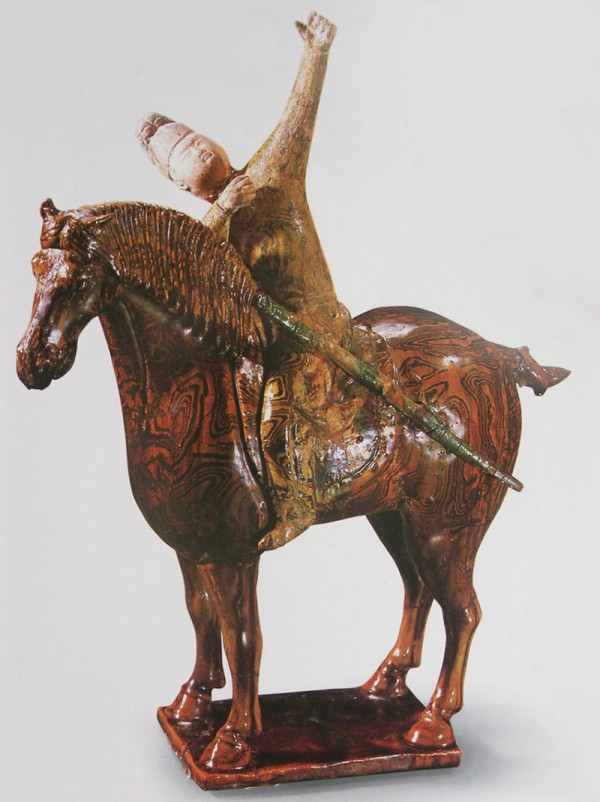Chinese ceramic technique involving mixed clays, Tang to modern times

The horse of the mounted hunter from the tomb of Prince Yide, Qianxian, Shaanxi, dated 706 (from the book 'Das Antike China). The text says that it is the only known figurine using marbled clay).
Definition and Technique:
Marbled wares, known in Chinese as jiao tai (絞胎, literally "twisted body"), are ceramics characterized by surface patterns that resemble natural marble, agate, wood grain, or feathers. These effects were achieved by physically mixing clays of contrasting colors—often by twisting, kneading, or layering—to form a variegated body. In some cases, the same visual effect was produced by applying two slips of different colors onto the surface and agitating them before glazing.
Mostly this kind of clay appears to have been prepared by light and dark clay sheets being rolled together, but not so much that the two mixes. From then on, slices were cut from the rolls, flattened, and press moulded into whatever shape they were making.
After forming, the piece was coated with a transparent glaze, commonly amber, green, or colorless, which emphasized the swirling patterns beneath and created a smooth, glossy surface.
Historical Origins and Development:
The marbling technique is thought to have originated under the influence of Roman marbled pottery and Mediterranean marbled glass, which reached China via the Silk Road. Roman examples of marbled pottery are known from at least the 1st century AD. A direct parallel is seen in a marbled glass bottle, made along the Mediterranean coast and recovered from an Eastern Han (25–220 AD) tomb in Luoyang, Henan province.
In China, jiao tai ceramics emerged as a frequent type during the Tang dynasty (618–907), with early production believed to have started at the Gongxian kiln in Henan province. The technique subsequently spread to other kiln centers in the region, including Dangyangyu (Xiuwu county) and Xiwangfeng and Encun (Jiaozuo county), all located in northern Henan.
Marbled wares were produced in a variety of forms—cups, bowls, jars, dishes, censers, pillows, and even tomb figurines such as horses—and enjoyed popularity among the Tang aristocracy. Some large items, such as pillows, incorporated marbled sections as decorative inlays into otherwise plain-bodied pieces.
Legacy and Continuation:
The technique continued into the Song dynasty (960–1279) and beyond. Although its prominence declined after the Tang, the method never fully disappeared and has been revived in later periods and modern studio pottery. Archaeological finds at Japanese sites, including marbled pillow shards at Daian-ji Temple in Nara, confirm the export and admiration of these wares in East Asia.
Today, jiao tai remains part of the repertoire of Chinese ceramic craftsmanship, with contemporary potters occasionally employing similar techniques to recreate or reinterpret traditional marbled effects.
Technical Considerations:
Producing marbled wares required advanced technical skill, especially when forming vessels from separately marbled sections (such as upper and lower halves) that needed to be precisely joined. Uniform glaze coverage and careful control of firing temperatures were also essential to preserve the clarity of the marbled pattern.
A